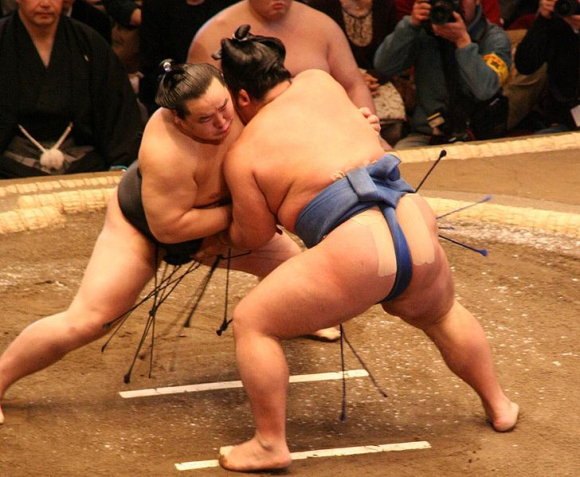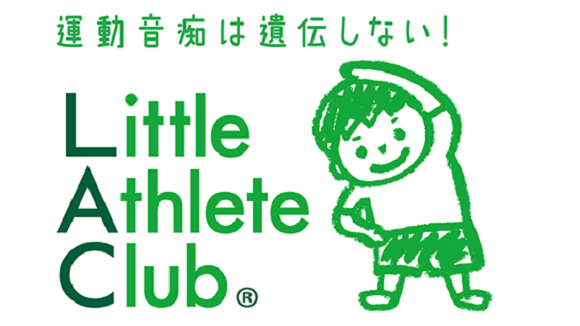
Remember when you were a little kid, and your parents would take you to the park to play? Not only were you having fun, you were developing important motor skills as you ran around, did somersaults, and swung on the monkey bars. Maybe when you got a little older and more coordinated, you’d even play catch with your mom and dad.
But did your parents love you enough to have a couple of sumo bouts against you?
Much like with mental development, the early years of a child’s life are critical in fostering the fundamental skills that underlie athletic ability. This principle has been espoused for years by fitness experts, including Kenta Toyama.
A graduate of Washington State University in the U.S., Toyama developed the programs at Little Athlete Club, a Japanese provider of children’s athletic programs. “There are individual differences as to the most important time for developing motor skills,” Toyama explains, “but the critical period is until around six years old, because the development of the nervous system at that young age is remarkable.”
Toyama isn’t suggesting that parents start training their kids to play a specific sport that early, though. Instead, he asserts that it’s important for children to do a wide variety of movements in order to develop as many related neural circuits as possible. That variety is the important thing, and it’s not necessary to push children past the level of intensity where they’re having fun playing.
Among the activities Toyama recommends is catching and throwing a ball, as the latter in particular involves a surprisingly complex series of coordinated muscle movements. Playing on the jungle gym is also a great choice, and as long as your toddler isn’t too heavy yet, the trainer also says there are benefits to getting down on all fours and letting your child ride you like a horse, which will foster good balance and posture.
“What I recommend the most, though,” he says, “is pretending to sumo wrestle.”
It’s unlikely that Toyama is actually advocating slapping your kid in the face and throwing him down in the dirt so much as playfully imitating the techniques of Japan’s massive fighters. He’s serious about the value of doing so, however. “Through sumo, children can learn many different skills, such as pushing, pulling, throwing, grabbing, and applying force and relaxing their muscles.”
Obviously, sumo is best done outside, unless your home happens to be big enough that you have space to set up a ring in your living room. But should your kids still manage to make a mess in the house, it turns out even that presents a developmental opportunity, since Toyama also has good things to say about having your kids help out with the housework. “By repeating the fundamental movements in cleaning floors or washing dishes, children’s’ manual dexterity, balance, and skill at handling tools are all refined, and their ability to concentrate is improved as well.”
Besides, if your kids develop a love of sumo that extends to the eating habits of the sport’s stars, you’re going to have way too many dishes to wash by yourself.
Related: Little Athlete Club
Source: Yahoo! Japan/R25
Top image: Wikipedia/Arcimboldo
Insert image: Little Athlete Club,


 Simple wrist test shows whether your body type is that of a model, athlete, or sumo wrestler
Simple wrist test shows whether your body type is that of a model, athlete, or sumo wrestler Japan Sumo Association bans girls from prohibiting in practice event as controversy continues
Japan Sumo Association bans girls from prohibiting in practice event as controversy continues What’s it like to watch a sumo tournament in Tokyo during the pandemic?
What’s it like to watch a sumo tournament in Tokyo during the pandemic? Old Enough: Netflix show sparks global debate on parenting and child safety
Old Enough: Netflix show sparks global debate on parenting and child safety 7 things that surprise a visitor to Laos 【Photos】
7 things that surprise a visitor to Laos 【Photos】 How to order snacks on a Shinkansen bullet train in Japan
How to order snacks on a Shinkansen bullet train in Japan Demon Slayer: Kimetsu no Yaiba gets new roller coaster attractions and food at Universal Studios Japan
Demon Slayer: Kimetsu no Yaiba gets new roller coaster attractions and food at Universal Studios Japan New samurai glasses are Japan’s latest weird must-have souvenir
New samurai glasses are Japan’s latest weird must-have souvenir Burger King Japan suddenly adds Dr. Pepper and Dr. Pepper floats to its menu nationwide
Burger King Japan suddenly adds Dr. Pepper and Dr. Pepper floats to its menu nationwide Nintendo history you can feel – Super NES, N64, and GameCube controllers become capsule toys
Nintendo history you can feel – Super NES, N64, and GameCube controllers become capsule toys High-fashion Totoro cuddle purse is like an elegant stroll in the forest【Photos】
High-fashion Totoro cuddle purse is like an elegant stroll in the forest【Photos】 Japan’s new difficult-to-drink-from beer glass protects your liver, but it’s a brutal experience
Japan’s new difficult-to-drink-from beer glass protects your liver, but it’s a brutal experience Kyoto Tower mascot termination reveals dark side behind cute Japanese characters
Kyoto Tower mascot termination reveals dark side behind cute Japanese characters New Pokémon ice cream, dessert drinks, and cool merch coming to Baskin-Robbins Japan【Pics】
New Pokémon ice cream, dessert drinks, and cool merch coming to Baskin-Robbins Japan【Pics】 To combat declining birth rate, Japan to begin offering “Breeding Visas” to foreigners
To combat declining birth rate, Japan to begin offering “Breeding Visas” to foreigners Hello, cosmetics! Clinique teams up with Hello Kitty this summer for first-time collaboration
Hello, cosmetics! Clinique teams up with Hello Kitty this summer for first-time collaboration “The most Delicious Cup Noodle in history” – Japan’s French Cup Noodle wins our heart【Taste test】
“The most Delicious Cup Noodle in history” – Japan’s French Cup Noodle wins our heart【Taste test】 Starbucks releases a cute Frappuccino and Unicorn Cake…but not in Japan
Starbucks releases a cute Frappuccino and Unicorn Cake…but not in Japan McDonald’s Japan’s Soft Twist Tower: A phantom ice cream only sold at select branches
McDonald’s Japan’s Soft Twist Tower: A phantom ice cream only sold at select branches Yabai Ramen: What makes this Japanese ramen so dangerous?
Yabai Ramen: What makes this Japanese ramen so dangerous? Finally! Nintendo Japan expands Switch 8-bit controller sales to everybody, Online member or not
Finally! Nintendo Japan expands Switch 8-bit controller sales to everybody, Online member or not Japanese government wants to build luxury resorts in all national parks for foreign tourists
Japanese government wants to build luxury resorts in all national parks for foreign tourists 10 things you should buy at 7-Eleven in Japan
10 things you should buy at 7-Eleven in Japan Studio Ghibli releases anime heroine cosplay dresses that are super comfy to wear
Studio Ghibli releases anime heroine cosplay dresses that are super comfy to wear Woman charged for driving suitcase without a license in Osaka
Woman charged for driving suitcase without a license in Osaka Studio Ghibli unveils My Neighbour Totoro miniature house model
Studio Ghibli unveils My Neighbour Totoro miniature house model Kyoto experiencing problems with foreign tourists not paying for bus fares, but not on purpose
Kyoto experiencing problems with foreign tourists not paying for bus fares, but not on purpose Fighting mild hunger with a Japanese soda that turns into jelly in the stomach【Taste test】
Fighting mild hunger with a Japanese soda that turns into jelly in the stomach【Taste test】 Studio Ghibli’s Howl’s Moving Castle tapestry unveiled in Japan for first time
Studio Ghibli’s Howl’s Moving Castle tapestry unveiled in Japan for first time McDonald’s new Happy Meals offer up cute and practical Sanrio lifestyle goods
McDonald’s new Happy Meals offer up cute and practical Sanrio lifestyle goods Sales of Japan’s most convenient train ticket/shopping payment cards suspended indefinitely
Sales of Japan’s most convenient train ticket/shopping payment cards suspended indefinitely Sold-out Studio Ghibli desktop humidifiers are back so Totoro can help you through the dry season
Sold-out Studio Ghibli desktop humidifiers are back so Totoro can help you through the dry season Japanese government to make first change to romanization spelling rules since the 1950s
Japanese government to make first change to romanization spelling rules since the 1950s Foreigner’s request for help in Tokyo makes us sad for the state of society
Foreigner’s request for help in Tokyo makes us sad for the state of society Ghibli founders Toshio Suzuki and Hayao Miyazaki contribute to Japanese whisky Totoro label design
Ghibli founders Toshio Suzuki and Hayao Miyazaki contribute to Japanese whisky Totoro label design Doraemon found buried at sea as scene from 1993 anime becomes real life【Photos】
Doraemon found buried at sea as scene from 1993 anime becomes real life【Photos】 Tokyo’s most famous Starbucks is closed
Tokyo’s most famous Starbucks is closed Princesses, fruits, and blacksmiths: Study reveals the 30 most unusual family names in Japan
Princesses, fruits, and blacksmiths: Study reveals the 30 most unusual family names in Japan Adorable judo girls still years away from making us scared, already able to make us smile
Adorable judo girls still years away from making us scared, already able to make us smile Sumo wrestler vs. 16-month-old toddler: The cutest match you’ll ever see【Video】
Sumo wrestler vs. 16-month-old toddler: The cutest match you’ll ever see【Video】 Sumo horse racing game returns with guest appearances from Street Fighter characters!
Sumo horse racing game returns with guest appearances from Street Fighter characters! Kids today get all the best toys! “Sketch Aquarium” turns doodles into lifelike swimming fish
Kids today get all the best toys! “Sketch Aquarium” turns doodles into lifelike swimming fish Should you put your kid on a leash? Japanese mothers weigh in
Should you put your kid on a leash? Japanese mothers weigh in Japan Sumo Association surprises fans with cutesy game on Twitter
Japan Sumo Association surprises fans with cutesy game on Twitter Japanese paralympic athlete plays emotive violin piece using her prosthetic arm as the bow【Video】
Japanese paralympic athlete plays emotive violin piece using her prosthetic arm as the bow【Video】 Grand Sumo Tournament pop-up cafe pushes its way into Fukuoka
Grand Sumo Tournament pop-up cafe pushes its way into Fukuoka Ninety-nine problems, but looking like a 5-year-old playa ain’t one of them
Ninety-nine problems, but looking like a 5-year-old playa ain’t one of them Naomi Osaka is first-ever Japanese athlete to be named AP Female Athlete of the Year
Naomi Osaka is first-ever Japanese athlete to be named AP Female Athlete of the Year Research from Tohoku University claims video games impair brain development in children
Research from Tohoku University claims video games impair brain development in children Four things women are banned from doing in Japan【Women in Japan Series】
Four things women are banned from doing in Japan【Women in Japan Series】 Can a bout of Nipple Sumo soothe workplace tensions between office bros? We investigate
Can a bout of Nipple Sumo soothe workplace tensions between office bros? We investigate What’s making these big, tough sumo wrestlers cringe? A tiny medical procedure, it turns out!
What’s making these big, tough sumo wrestlers cringe? A tiny medical procedure, it turns out!
Leave a Reply